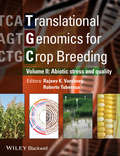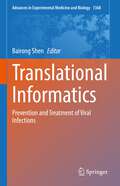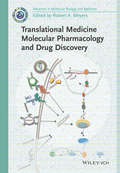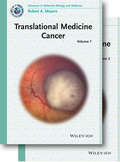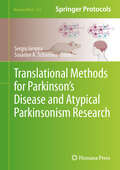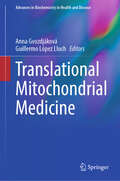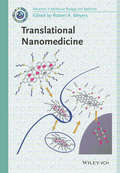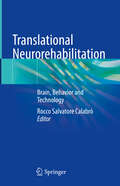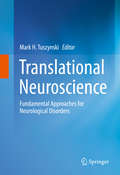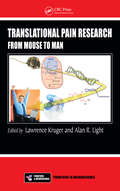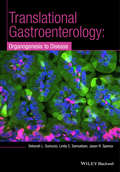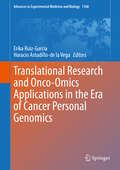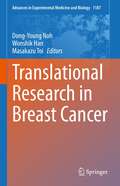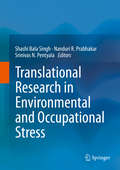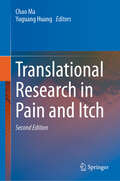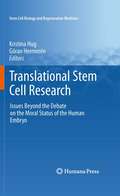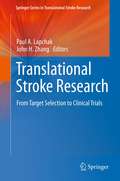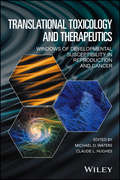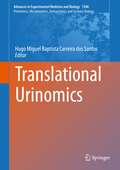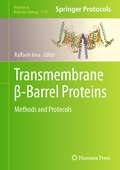- Table View
- List View
Translational Genomics for Crop Breeding: Improvement for Abiotic Stress, Quality and Yield Improvement
by Rajeev K. Varshney Roberto TuberosaGenomic Applications for Crop Breeding: Abiotic Stress, Quality and Yield Improvement is the second of two volumes looking at the latest advances in genomic applications to crop breeding. This volume focuses on advances improving crop resistance to abiotic stresses such as extreme heat, drought, flooding as well as advances made in quality and yield improvement. Chapters examine advances in such key crops as rice, maize, and sugarcane, among others. Genomic Applications for Crop Breeding: Abiotic Stress, Quality and Yield Improvement complements the earlier volume on biotic stressors and will be an essential purchase for those interested in crop science and food production.
Translational Informatics: Sports and Exercise Medicine (Advances In Experimental Medicine And Biology Ser. #1005)
by Bairong ShenThe book provides readers the informatics and data-driven models for the discovery of personalized excise prescriptions applied to different cases. Overdiagnosis or over-treatment often happened since the complex interaction among the lifestyle, genetic, and environmental factors. Sports and exercise are reported efficient to prevent or reduce the risk of diseases, but the interactions between sports/exercise and disease are personalized and complex. Translational informatics is a powerful paradigm and it promotes the transfer of big data, knowledge and models to the precision application of sports to prevent diseases. Sports and exercise may have different effects on diverse diseases including cancers, neurodegenerative disease, and cardiovascular diseases, etc. This book covers many modern informatics models such as ontologies, knowledge graphs, blockchain, participatory medicine, semantic artificial intelligence, big data modeling, and so on. It also describes the challenges for the sports and exercise medical data sharing and standardization, the privacy protection of data as well as the integration of data from genomic level to physiological phenotype level. This book will be helpful to the readers who are interesting in sports and exercise medicine, healthcare, big data modeling, artificial intelligence in medicine and healthcare.
Translational Informatics: Prevention and Treatment of Viral Infections (Advances in Experimental Medicine and Biology #1368)
by Bairong ShenThis book introduces the translational informatics applied to most aspects of virus infection, including tracking of virus origin, detection and prevention of infection, drug discovery, and vaccine design as well as smart city-level monitoring and controlling of the virus epidemic by government. It covers the informatics for data mining and modelling at molecular, tissue/organ, individual, and population levels. The informatics for immunological mechanisms and the personalized prediction and treatment of infected patients are also summarized. The perspectives on the application of artificial intelligence to the prevention of virus outbreaks are also given. This book will be helpful to readers who are interested in prevention of virus infection, biomedical informatics, and artificial intelligence in medicine and healthcare.
Translational Medicine: Molecular Pharmacology and Drug Discovery (Current Topics from the Encyclopedia of Molecular Cell Biology and Molecular Medicine)
by Robert A. MeyersThis reference work gives a compete overview of the different stages of drug development using a translational approach. The book is structured in different parts, following the different stages in drug development. Almost half of the work is dedicated to core of drug discovery using a translational approach, the identification of appropriate targets and screening methods for the identification of compounds interacting with these targets. The rest of book covers the whole downstream pipeline after the identification of lead compounds, such as bioavailability issues, identification of appropriate drug delivery venues, production and scaling issues and preclinical trials. As has been the case with other works in the encyclopedia, the book is made up of long, comprehensive and authoritative chapters, written by outstanding researchers in the field.
Translational Medicine 2 Volume Set: Cancer
by Robert A. MeyersThe first complete overview of progress in the field. The two volumes contain selected articles from the prestigious online Encyclopedia of Molecular Cell Biology and Molecular Medicine, fully updated and enriched with numerous new contributions from many eminent scientists. Divided into three parts, the first gives a thorough introduction to cancer biology, while Part Two covers therapeutic approaches for all major forms of cancer, and the third part deals with cancer diagnostics. The result is a one-stop resource for advanced students, postdoctoral researchers and start-up companies.
Translational Methods for Parkinson’s Disease and Atypical Parkinsonism Research (Neuromethods #213)
by Sergiu Groppa Susanne A. SchneiderThis volume provides readers with an overview of translational paths that can be used to study the pathophysiology of Parkinson’s Disease and atypical parkinsonism, including molecular processes, tissue integrity, and cerebral networks during inflammatory and neurodegenerative processes. The chapters in this book are organized into three parts and cover topics such as new developments of cerebral circuit characterizations and computational neuroscience for the description of the brain’s transition through disease stages; static and dynamic systemic changes with clinical and functional outcome measures; and atypical syndromes such as neurodegenerations, immunological processes, and progressive disease states. In the Neuromethods series style, chapters include the kind of detail and key advice from the specialists needed to get successful results in your laboratory. Cutting-edge and comprehensive, Translational Methods for Parkinson’s Disease and Atypical Parkinsonism Research is a valuable resource that provides a new perspective on the disease from a scientific and clinical point of view, and highlights the importance of available and emerging technologies.
Translational Mitochondrial Medicine (Advances in Biochemistry in Health and Disease #32)
by Anna Gvozdjáková Guillermo López LluchTranslational mitochondrial medicine applies the knowledge of experimental medicine in clinical practice, it is a prospective direction of the development of mitochondrial medicine. The monograph "Translational Mitochondrial Medicine" was created on the basis of rapidly developing new information about mitochondrial diseases and their disorders, is a revised and supplemented edition of the monographs: "Mitochondrial Medicine", ed. A. Gvozdjáková, Springer, 2008 and "Recent Advances in Mitochondrial Medicine and Coenzyme Q10", eds. A. Gvozdjáková, G. Cornélissen, RB Singh, NOVA Science, USA, 2018. The monograph was created as part of the book series "Advances in biochemistry in health and disease", edited by prof. Naranjan Dhalla of Winnipeg, for which we are grateful. The book"Translational Mitochondrial Medicine" contributes to the elucidation of the pathobiochemical mechanisms of various diseases, provides current information on the prospective application of the latest diagnostic approaches and targeted therapy of mitochondrial diseases. Perspective mtDNA diagnostic methods include new technologies based on NGS (Next Generation Sequencing) to identify new genes associated with mitochondrial diseases. With the help of the high resolution respirometry method (HRR), it is possible to record even the most subtle deviations of the bioenergetics of mitochondria in blood cells, it contributes to the monitoring of the used daily doses of drugs in patients with various diseases. Determination of the endogenous level of coenzyme Q10 (CoQ10) in platelets is a key method to improve the diagnosis and targeted therapy of damaged mitochondrial bioenergetics. Perspective therapeutic strategies for damaged mitochondria include mitochondrial transplantation, plasma therapy, mitochondrial nanotherapy, weight reduction in obesity, spa rehabilitation, the influence of molecular hydrogen and oxygen therapy. Targeted therapeutic methods for dysfunctional mitochondria and CoQ10 deficiency include supplementation with CoQ10, antioxidants and vitamins. This volume is intended for researchers and physicians looking for new prospective diagnostic approaches and targeted therapies for dysfunctional mitochondria in their patients.
Translational Nanomedicine (Current Topics from the Encyclopedia of Molecular Cell Biology and Molecular Medicine)
by Robert A. MeyersThe largest high-level encyclopedia on molecular medicine is now publishing a topical volume on Nanomedicine. The long awaited volume gives a comprehensive overview on nanomaterials in drug delivery, imaging and as therapeutics.
Translational Neurorehabilitation: Brain, Behavior and Technology
by Rocco Salvatore CalabròThis book focuses on rehabilitation demonstrating how translational research may help clinicians in boosting neural plasticity and functional recovery. Translational Neurorehabilitation is a new interesting field that seeks to produce more meaningful, applicable rehabilitation results that directly enhance human health, performance and quality of life. As neurological diseases increase with age and people who survive a brain injury are rising, thanks to the improvement of intensive acute care, the need to appeal to neurorehabilitation will double in the next few years. Motor, cognitive and behavior approaches have changed over the years and novel tools to treat brain and spinal cord injury should be validated before translating them into clinical practice. The book is aimed to expand the current understanding of brain function and disease by evaluating preclinical and clinical trials on neural plasticity and functional recovery after nervous system disorders. Also, it disseminates the knowledge coming from novel therapies, including advanced robotic and ICT-based applications. The book will be of interest to neuroscientists, physiatrists, neural engineers, and clinical neurologists.
Translational Neuroscience:
by James E. Barrett Joseph T. Coyle Michael WilliamsTranslational neuroscience is at the heart of clinical advancement in the fields of psychiatry, neurology and neurodevelopmental disorders. Written and edited by leading scientists and clinicians, this is a comprehensive and authoritative analysis of this emerging strategy for developing more effective treatments for brain disorders. Introductory chapters bring together perspectives from both academia and industry, while subsequent sections focus on disease groups, including bipolar disorder and depression, attention deficit hyperactivity disorder, substance abuse, autism, Alzheimer's disease, pain, epilepsy, Parkinson's disease and multiple sclerosis. Each section includes topical introductory and summary chapters, providing an overview and synthesis of the field. Translational Neuroscience: Applications in Neurology, Psychiatry, and Neurodevelopmental Disorders is an important text for clinicians, scientists and students in academic settings, government agencies and industry, as well as those working in the fields of public health and the behavioural sciences.
Translational Neuroscience
by Mark H. TuszynskiTranslational Neuroscience offers a far-reaching and insightful series of perspectives on the effort to bring potentially revolutionary new classes of therapies to the clinic, thereby transforming the treatment of human nervous system disorders. Great advances in the fields of basic neuroscience, molecular biology, genomics, gene therapy, cell therapy, stem cell biology, information technology, neuro devices, rehabilitation and others over the last 20 years have generated unprecedented opportunities to treat heretofore untreatable disorders of the nervous system. This book provides a wide-ranging yet detailed sample of many of these efforts, together with the methods for pursuing clinical translation and assessing clinical outcomes. Among the topics covered are Alzheimer's disease, Parkinson's disease, stroke, multiple sclerosis, epilepsy, motor neuron disease, pain, inborn errors of metabolism, brain tumors, spinal cord injury, neuroprosthetics, rehabilitation and clinical trial design/consideration. Translational Neuroscience is aimed at basic neuroscientists, translational neuroscientists and clinicians who seek to gain a perspective on the nature and promise of translational therapies in the current era. Both students and established professionals will benefit from the content.
Translational Pain Research: From Mouse to Man (Frontiers in Neuroscience)
by Lawrence Kruger Alan R. LightOne of the Most Rapidly Advancing Fields in Modern Neuroscience The success of molecular biology and the new tools derived from molecular genetics have revolutionized pain research and its translation to therapeutic effectiveness. Bringing together recent advances in modern neuroscience regarding genetic studies in mice and humans and the practical
Translational Research and Discovery in Gastroenterology
by Linda C. Samuelson Deborah L. Gumucio Jason R. Spencepathways of GI organ development alongside clinical chapters examining organ-based diseases, closing the gap between the bench and the clinic. * Derivative organs - esophagus, stomach, pylorus, small intestine, colon, liver, and pancreas -as well as tissues such as serosa and enteric nervous system that are common to multiple GI organs. * Chapters detailing the use of model organisms - Drosophila, sea urchin, zebrafish, C. elegans, Xenopus - for basic discovery studies are included. * Chapters on GI stem cells and the potential for tissue engineering of the GI organs provide a view to the future of research and therapy in these organs.
Translational Research and Onco-Omics Applications in the Era of Cancer Personal Genomics (Advances in Experimental Medicine and Biology #1168)
by Erika Ruiz-Garcia Horacio Astudillo-de la VegaBeing a complex disease that affects millions of people world over, cancer research has assumed great significance. Translational cancer research transforms scientific discoveries in the laboratory into clinical application to reduce incidence of cancer, morbidity and mortality. On the other hand, personalized medicine in cancer is the concept that selection of a treatment should be tailored according to the individual patient’s specific genomic characteristics, including mutations, chromosomal aberrations, protein interactions, and SNPs, and even more, taking into account the inmume system, the metabolism and maybe in the next future also the microbiome.
Translational Research in Breast Cancer (Advances in Experimental Medicine and Biology #1187)
by Dong-Young Noh Wonshik Han Masakazu ToiThis book describes recent advances in translational research in breast cancer and presents emerging applications of this research that promise to have meaningful impacts on diagnosis and treatment. It introduces ideas and materials derived from the clinic that have been brought to "the bench" for basic research, as well as findings that have been applied back to "the bedside". Detailed attention is devoted to breast cancer biology and cell signaling pathways and to cancer stem cell and tumor heterogeneity in breast cancer. Various patient-derived research models are discussed, and a further focus is the role of biomarkers in precision medicine for breast cancer patients. Next-generation clinical research receives detailed attention, addressing the increasingly important role of big data in breast cancer research and a wide range of other emerging developments. An entire section is also devoted to the management of women with high-risk breast cancer. Translational Research in Breast Cancer will help clinicians and scientists to optimize their collaboration in order to achieve the common goal of conquering breast cancer.
Translational Research in Environmental and Occupational Stress
by Shashi Bala Singh Nanduri R. Prabhakar Srinivas N. PentyalaCutting edge technologies can propel a simple finding in basic science to a concept that can be of immense value to the society. While applying novel techniques to unravel the mysteries of biological processes, an offshoot of applied branch emerged. This field, which is now widely referred to as Translational Research utilizes basic science findings and translates these findings into innovative concepts for the benefit of mankind. This branch of science has evolved into a multidisciplinary juggernaut encompassing all known fields of science as varied as biomedicine, environment, law, economics, sociology, etc. With the ever increasing interest in this branch and the dreams and aspirations that this field can bring, basic science researchers are now taking a bold step into this new realm, merging different fields of knowledge to come up with novel inventions. This book "Translational research in environmental and occupational stress" provides and insight into the research that led to discoveries, inventions and development of novel technologies which will have a tremendous impact on the future of mankind.
Translational Research in Pain and Itch
by Chao Ma Yuguang HuangThis book provides a comprehensive review of the latest advances in translational pain and itch research, and presents the cutting-edge developments in the study of our two principal, yet most mysteries sensations. Despite the slow progress in the discovery of effective therapies for chronic pain and pruritus, scientists around the globe now have a better understanding of why and how these conditions occur. Based on these findings, a series of novel treatment strategies are currently under development, and hopefully in a few years, medical practitioners will become more confident and optimistic when facing patients with these annoying and sometimes severe disorders. The contributing authors are world-renowned research scientists, who have made significant discoveries. The book is of interest to neuroscientists, neurologists and pharmacologists in both clinical and basic medical research field. In this second edition of the book, five existing chapters have been updated. Five new chapters have been added to reflect the lasted developments in the related field of research.
Translational Research in Traumatic Brain Injury (Frontiers In Neuroscience Ser.)
by Daniel Laskowitz Gerald GrantTraumatic brain injury (TBI) remains a significant source of death and permanent disability, contributing to nearly one-third of all injury related deaths in the United States and exacting a profound personal and economic toll. Despite the increased resources that have recently been brought to bear to improve our understanding of TBI, the developme
Translational Stem Cell Research
by Göran Hermerén Kristina HugFor many years, the ethical discussion surrounding human embryonic stem cell research has focused on the moral status of the embryo. This text takes a wider moral berth and focuses on numerous ethical, legal and social aspects involved in translating the results of stem cell research into diagnostic and therapeutic applications. Translational Stem Cell Research is broken into ten sections. It opens with an overview of the latest in stem cell research, focusing on specific diseases and the treatment of burn victims. Part II discusses the issues involved in the many steps from bench to bedside, ranging from first research in vitro to clinical trials. Part III covers scientific, regulatory and ethical challenges to basic research, and Part IV details issues regarding stem cell banks. Part V explores ethical, economic and strategic issues involved in collaboration between universities and industry, and Part VI addresses legal problems raised by patents on human stem-cell based inventions plus the extent to which there can be technological solutions to a moral dilemma. Part VII presents imaginative ways of communicating research to the general public and how to create conditions for a constructive dialogue. Part VIII probes psychosocial and cultural factors affecting judgment and decisions about translational stem cell research, and Part IX explores problems and procedures raised by an examination of the evaluation of stem cell research projects in research ethics committees. The book closes with a look into the future of translational stem cell research and stem cell-based therapeutic applications.
Translational Stroke Research
by Paul A. Lapchak John H. ZhangThis volume sets a basis for effective translational research. Authored by experts in the field of translational stroke research, each chapter specifically addresses one or more components of preclinical stroke research. The emphasis is placed on target identification and drug development using state-of-the-art in vitro and in vivo assays, in combination with in vitro toxicology assays, AMDE and clinical design.
Translational Toxicology and Therapeutics: Windows of Developmental Susceptibility in Reproduction and Cancer
by Michael D. Waters Claude L. HughesWritten by leading research scientists, this book integrates current knowledge of toxicology and human health through coverage of environmental toxicants, genetic / epigenetic mechanisms, and carcinogenicity. Provides information on lifestyle choices that can reduce cancer risk Offers a systematic approach to identify mutagenic, developmental and reproductive toxicants Helps readers develop new animal models and tests to assess toxic impacts of mutation and cancer on human health Explains specific cellular and molecular targets of known toxicants operating through genetic and epigenetic mechanisms
Translational Urinomics (Advances in Experimental Medicine and Biology #1306)
by Hugo Miguel Baptista Carreira dos SantosTranslational Urinomics provides an overview of urine analysis using proteomics, metabolomics, transcriptomics or any combination thereof for the diagnosis and prognosis of diseases related to the urinary system and the kidneys. The text approaches urine biomarkers from a new perspective, incorporating up-to-date studies of mass-spectrometry-based biomarker discovery as well as the latest advances in personalized medicine. The integration of technology-driven techniques, such as OMICS also provides a unique opportunity for improved diagnostics accuracy of urinary-related diseases. For nephrologists and urologists looking for new approaches to well-known problems, this edited volume serves as a valuable guide.
Transmembrane β-Barrel Proteins: Methods and Protocols (Methods in Molecular Biology #2778)
by Raffaele IevaThis detailed volume explores experimental strategies and protocols for the expression, assembly, characterization, and exploitation of transmembrane β-barrel proteins. Beginning with methodologies to study their assembly, the book continues with protocols for characterizing the landscape of transmembrane β-barrel protein interactions with other cellular factors, dissecting processes of protein transport in bacteria and mitochondria, examining structural characterization, determination, and prediction, and more. Written for the highly successful Methods in Molecular Biology series, chapters include introductions to their respective topics, lists of the necessary materials and reagents, step-by-step and readily reproducible laboratory protocols, and tips on troubleshooting and avoiding known pitfalls. Authoritative and practical, Transmembrane β-Barrel Proteins: Methods and Protocols serves as an ideal guide for researchers seeking to expand our knowledge of these vital membrane-spanning proteins.
Transmembrane Dynamics of Lipids (Wiley Series in Protein and Peptide Science #9)
by Andreas HerrmannThe first and only book devoted entirely to MEMBRANE LIPID ASYMMETRY AND ITS BIOLOGICAL IMPLICATIONS Transmembrane Dynamics of Lipids is comprised of contributions from expert authors from leading research groups that present up-to-date quantitative data on the formation, stability, and biological consequences of the asymmetrical organization of lipids in cell membranes. Incorporating an impressive amount of new, previously uncollected data, the book examines transmembrane asymmetry and movement of lipids in biological membranes, and methods for the measurement of transmembrane lipid motion, emphasizing the role of lipid flippases and discusses biological functions associated with lipid asymmetry. In addition, it draws attention to important new discoveries in the field, such as the correlation between malfunction of lipid flippases and human diseases such as thrombosis and cancer. The book also addresses the manifold methods that are used to measure the rate of transmembrane movement of lipids in biological and model systems. The only guide to new discoveries regarding lipids in cell membranes, Transmembrane Dynamics of Lipids is designed to appeal to biophysicists, biochemists, and cellular and molecular biologists working in the growing field of membrane research.
Transmembrane Signaling Protocols
by Hydar Ali Haribabu BodduluriThis fully updated and expanded second edition of Transmembrane Signaling Protocols demonstrates the use of such techniques as single cell imaging, bioluminecence resonance energy transfer, and global proteomics in the study of transmembrane signaling events. Highlights include the functional expression and genetic selection of mutant mammalian transmembrane receptors in yeast, real-time analysis of transmembrane receptor signaling in live cells, and bioluminescence energy transfer to monitor protein-protein interaction. Additional chapters use state-of-the-art methods to analyze gene expression and proteomic profiles related to transmembrane signaling events, as well as to genetically reconstitute bone marrow for the study of signal transduction ex vivo. The protocols follow the successful Methods in Molecular BiologyTM series format, each offering step-by-step laboratory instructions, an introduction outlining the principles behind the technique, lists of the necessary equipment and reagents, and tips on troubleshooting and avoiding known pitfalls.
